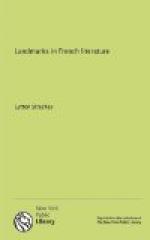Chateaubriand’s influence was very great. Beside his high-flowing, romantic, imaginative writings, the tradition of the eighteenth century seemed to shrivel up into something thin, cold and insignificant. A new and dazzling world swam into the ken of his readers—a world in which the individual reigned in glory amid the glowing panorama of Nature and among the wondrous visions of a remote and holy past. His works became at once highly popular, though it was not until a generation later that their full effect was felt. Meanwhile, the impetus which he had started was continued in the poems of LAMARTINE. Here there is the same love of Nature, the same religious outlook, the same insistence on the individual point of view; but the tints are less brilliant, the emphasis is more restrained; the rhetorical impulse still dominates, but it is the rhetoric of elegiac tenderness rather than of picturesque pomp. A wonderful limpidity of versification which, while it is always perfectly easy, is never weak, and a charming quietude of sentiment which, however near it may seem to come to the commonplace, always just escapes it—these qualities give Lamartine a distinguished place in the literature of France. They may be seen in their perfection in the most famous of his poems, Le Lac, a monody descriptive of his feelings on returning alone to the shores of the lake where he had formerly passed the day with his mistress. And throughout all his poetical work precisely the same characteristics are to be found. Lamartine’s lyre gave forth an inexhaustible flow of melody—always faultless, always pellucid, and always, in the same key.
* * * * *
During the Revolution, under the rule of Napoleon, and in the years which followed his fall, the energies of the nation were engrossed by war and politics. During these forty years there are fewer great names in French literature than in any other corresponding period since the Renaissance. At last, however, about the year 1830, a new generation of writers arose who brought back all the old glories and triumphantly proved that the French tongue, so far from having exhausted its resources, was a fresh and living instrument of extraordinary power. These writers—as has so often been the case in France—were bound together by a common literary creed. Young, ardent, scornful of the past, dazzled by the possibilities of the future, they raised the standard of revolt against the traditions of Classicism, promulgated a new aesthetic doctrine, and, after a sharp struggle and great excitement, finally succeeded in completely establishing their view. The change which they introduced was of enormous importance, and for this reason the date 1830 is a cardinal one in the literature of France. Every sentence, every verse that has been written in French since then bears upon it, somewhere or other, the imprint of the great Romantic Movement which came to a head in that year. What it was that was then effected—what the main differences are between French literature before 1830 and French literature after—deserves some further consideration.




